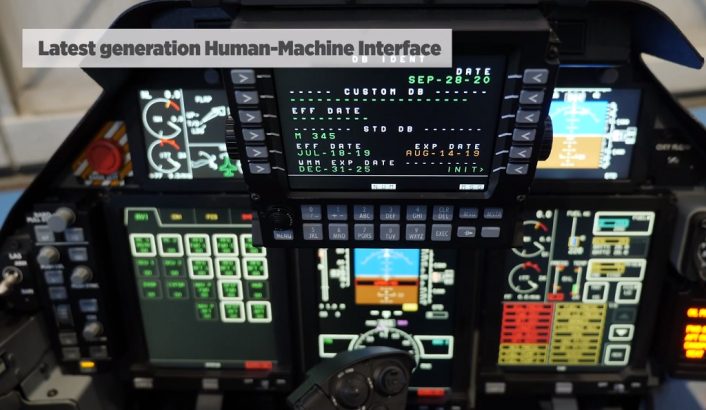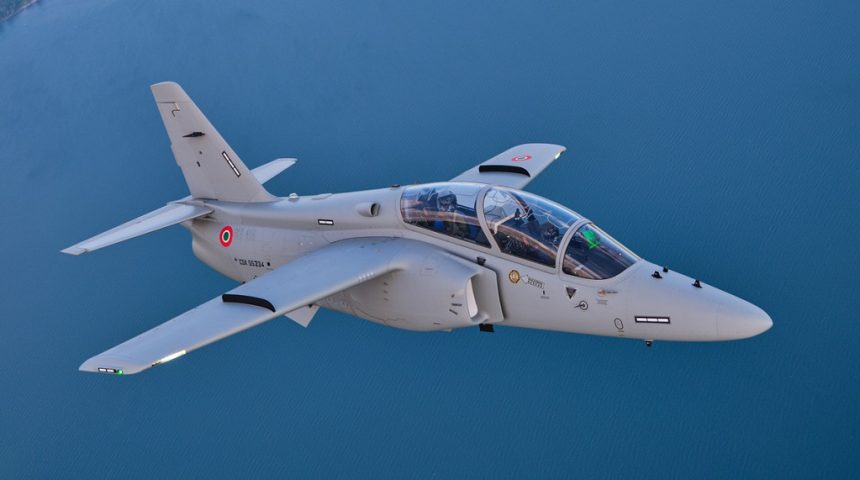The video gives some insights about the systems aboard the M-345 trainer aircraft and also the first glimpse of the advanced cockpit.
As you may already know, just before Christmas, the Italian Air Force received the first two Leonardo M-345 (designated T-345 by the Aerobautica Militare) next-generation trainer aircraft. A couple of weeks later, Leonardo published on its website and YouTube channel a walkaround of the new aircraft with Captain Quirino Bucci, Head of Project Test Pilot Trainers.
Captain Bucci has been involved at every stage of the aircraft’s development, since even before the first flight. “The aircraft is fitted with simple essential systems for maximum safety and reliability with minimum maintenance needs. As a result, the M-345 is a turbofan-powered high efficiency trainer with life-cycle cost comparable to those of heavy turboprop trainers, but with better performance”, said Bucci in the introduction.
The aircraft, with a fatigue life of 15,000 flight hours, features a widespread use of advanced composite materials, with a resulting take-off weight of 7,715 lb (in the standard training configuration). The engine is a Williams FJ44-4M-34 turbofan, a variant of the engine used on many business jets like the Beechcraft Premier I, the Cessna CitationJet or the Pilatus PC-24, just to name a few.
The M-345, with the help of its 1,540 kg (3,400 lb) of thrust, can fly up to 40,000 ft at a maximum rate of climb of 4,700 ft/min, with limit load factors of +7/-3.5 g, a high sustained load factor of 4 g and a max speed of 380 KTAS at sea level or 425 KTAS at 20,000 ft, while the stall speed in landing configuration is 92 KCAS. The max range is reported as 760 nm in clean configuration and 1,000 NM with external fuel tanks, with an endurance of 150 minutes and 250 minutes respectively.
Bucci continues: “The aircraft has been designed to ensure the maximum level of safety, ideal comfort and field of view for both the instructor in the rear cockpit and the student in the front cockpit”. One of the aspects that insure this level of safety is the presence of two Martin Baker Mk.IT16D ejection seats with 0-0 capability (0 speed, 0 altitude), On-Board Oxygen Generation System (OBOGS) and Environmental Control System (ECS).
The walkaround provides us with a first look in the cockpit, where Leonardo integrated the latest generation Human-Machine Interface concepts which prominently features three 5×7 inches LCD touchscreen Multi-Function Displays (MFD), together with two stand-by/backup displays and an Up-Front Control Panel (UFCP) to manage the avionics. The cockpit is completed by a Head-Up Display (HUD) in the front and an HUD repeater in the back for the instructor. Both cockpits feature also a digital moving map, Hands On Throttle And Stick (HOTAS) controls and Night Vision Imaging System (NVIS) compatibility. An additional layer of safety is provided by two mission computers for “hot redundancy”.
Additional systems for the pilots are an Embedded GPS/Inertial Navigation System and Radar altimeter (EGIR), TACAN, VOR/ILS/MB navigation aids, two sets of V/UHF radios, Identification Friend or Foe (IFF) transponder, Traffic Advisory System (TAS), Traffic Collision Avoidance System (TCAS) and an optional Stormscope weather mapping sensor (which we don’t know if has been installed on the aircraft delivered to the Italian Air Force).
The M-345 inherited from its bigger brother M-346 one of its most valuable features, the Embedded Tactical Training System (ETTS). The ETTS can be used during advanced training to provide onboard simulation of tactical scenarios, realistic computer-generated threats, sensor simulation of systems like radar, targeting pods and ECM systems which are not physically installed on the aircraft, and of course simulated weapons. This way the M-345, like the M-346, can take advantage of the Live, Virtual, Constructive (LVC) training environment.
The M-345 can also carry not only simulated weapons, but also real weapons, with a 2425 lb payload under four wing hardpoints and with the capability to employ gun pods, rockets, IR-guided air-to-air missiles and 500 lb class bombs.
Like the M346, the M-345 is integrated in an advanced training system which includes a complete Ground Based Training System (GBTS) package featuring Computer-Based Training (CBT), the Procedural Training Device (PTD), a Mission Support Station for Planning, Briefing and De-briefing, a Part Task Trainer (PTT) with a 180° wide-screen display and a Full Mission Simulator (FMS) with a 360° visual display system. While not specified, it is possible that pilots in the simulator may be able to fly together with pilots flying in the real aircraft, similarly to the M-346 GBTS.

Because of its affordability and low operating cost, the aircraft is being advertised as an ideal basic-advanced jet training solution. At the end of the video, the M-345 is compared with some of its competitors. Interestingly, while the competitors are not named, their shapes are clearly recognizable. The “best performing turboprop trainer competitor” is actually a Pilatus PC-21, while the “main jet competitor” is a Aero-Vodochody L-39NG, which by the way uses the same engine of the M-345.
As we already reported, the Italian Air Force ordered 18 M-345As (a number that may increase up to 45 aircraft) to start replacing the ageing MB-339s, together with ground-based training systems similar to the ones developed for the M-346 advanced trainer. It will be used for Phase 2 and Phase 3 training, where students obtain their Military Pilot Licenses before moving to Phase 4, the Lead-In Fighter Training with the T-346A Master. The new aircraft will also become the new platform of the Italian Air Force’s Frecce Tricolori display team.









